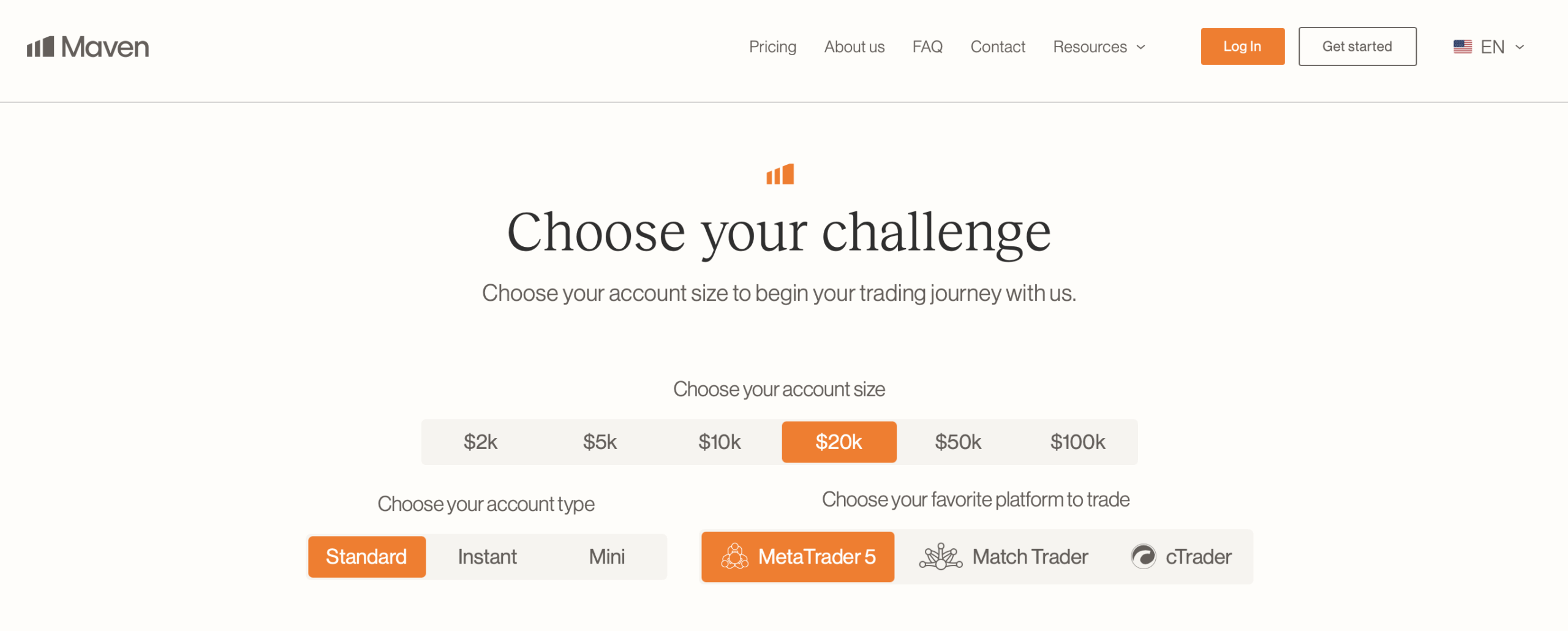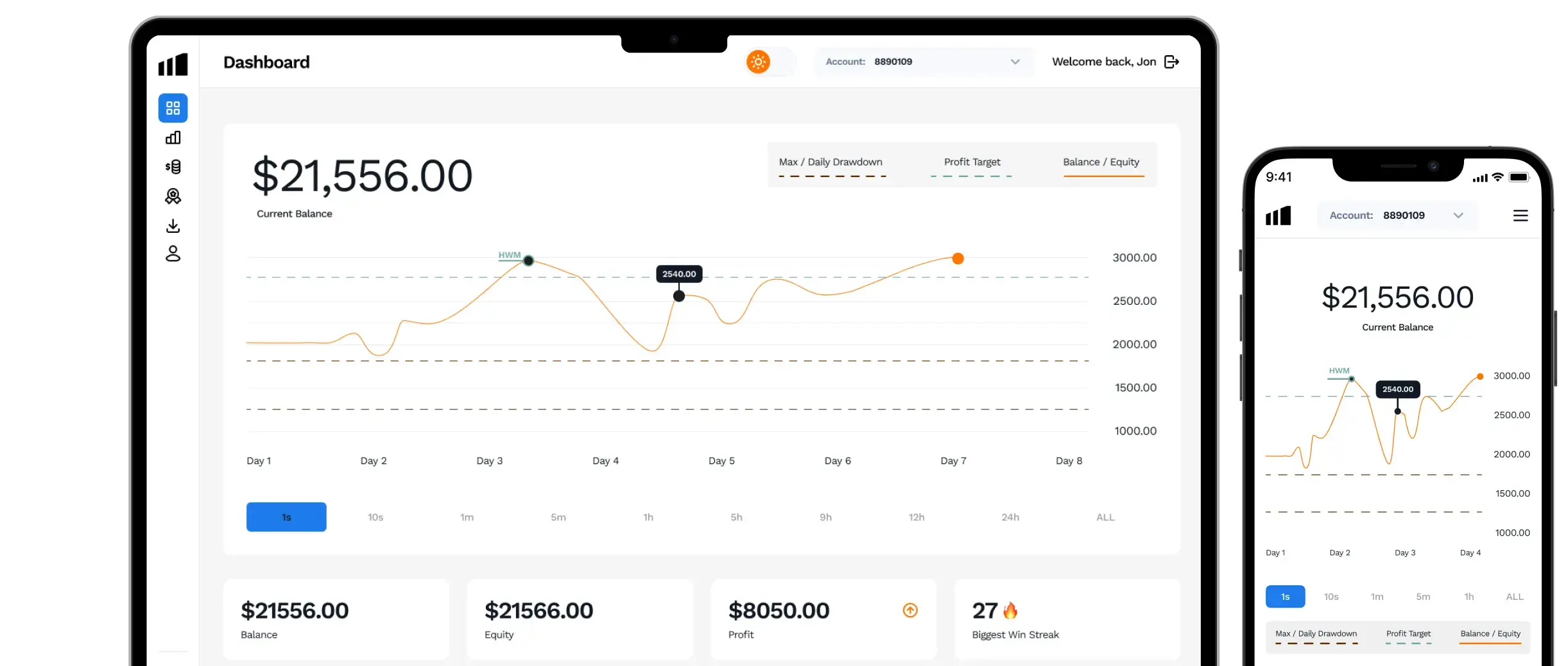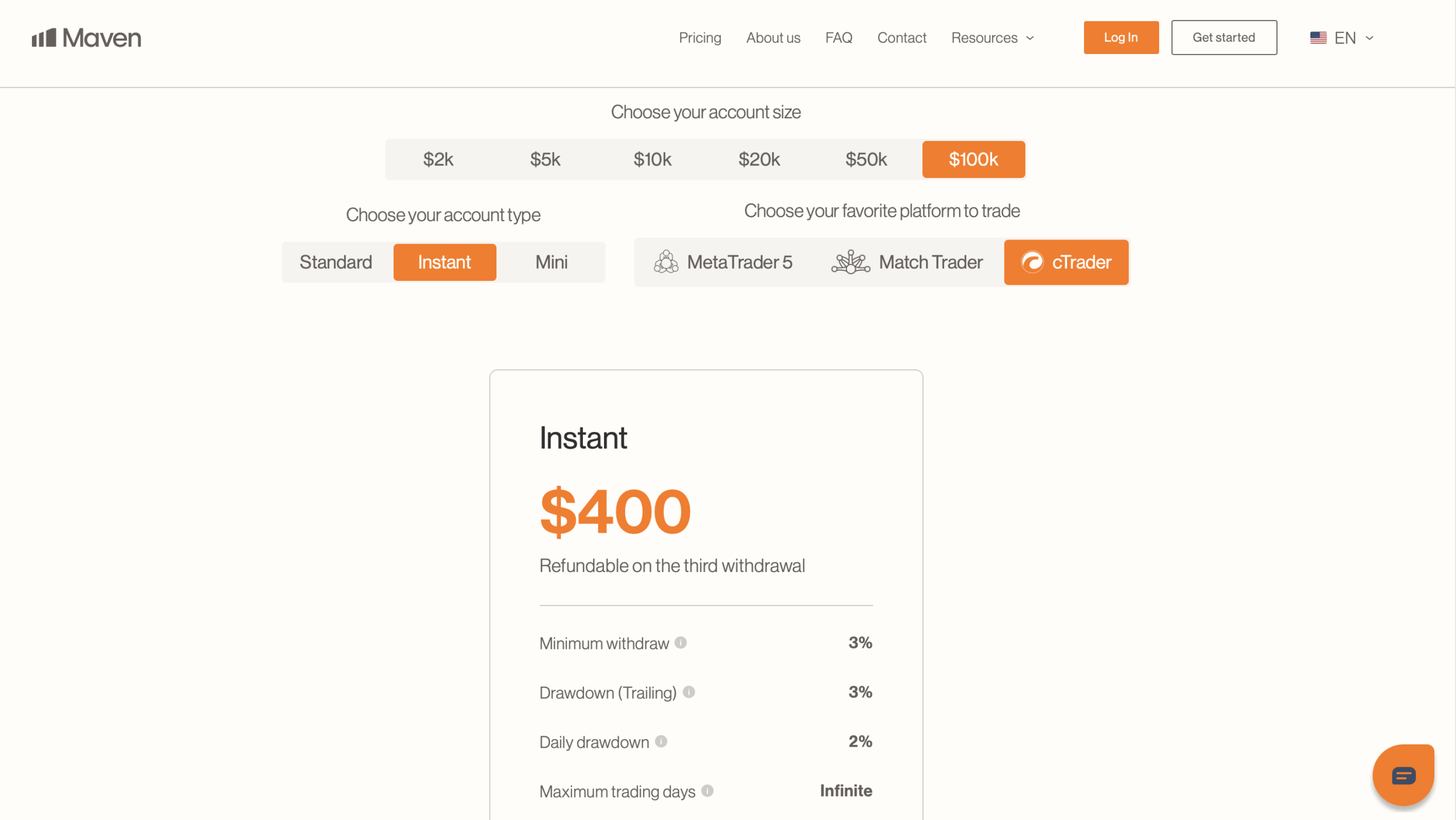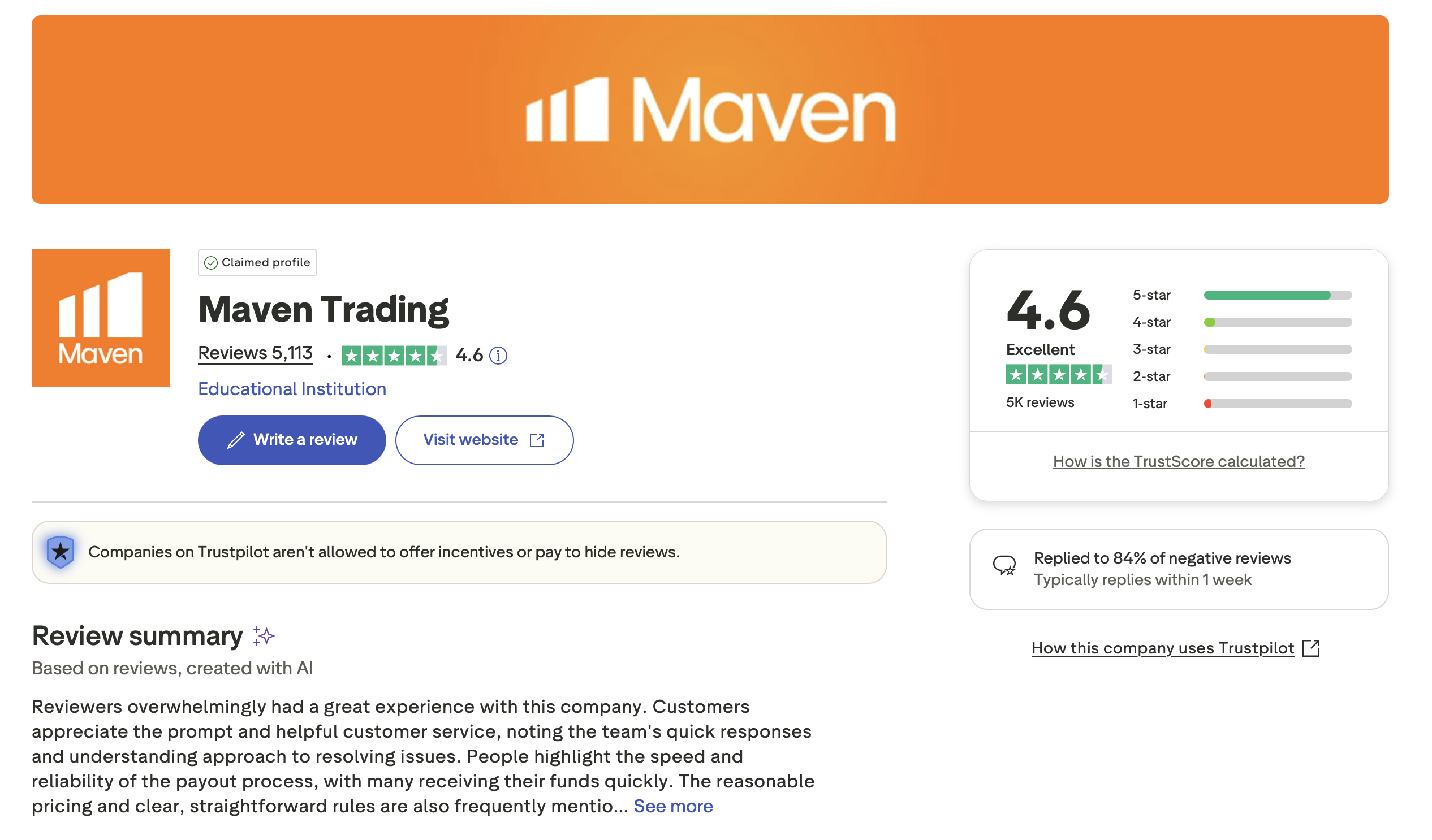Maven Trading Review: Pros, Cons, Payouts & Challenges

- Low-cost accounts
- Viable option for US clients
- Buyback feature on funded accounts
- Fast and reliable customer service
- Actively replies to negative feedback
- Generally trusted to pay out profits
- No swap fees for all of its accounts
- Regular payout (every 10 days if eligible)
- Support for major trading platforms
- No hidden rules
- Additional fee for cTrader
- Only up to 80% profit split
- Relatively high and not competitive spreads (trade-off for cheap accounts)
- Slippage is a common pain point in the community
- Less reputable than established names
- Payout every 10 days is slower than some top prop firms
- Low account ceiling of $100,000
Maven Trading (which we will refer to simply as “Maven”) is a relatively new prop firm (with less than 3 years of track record) known for its low-cost account offerings and an overall good reputation when it comes to paying out profitable traders. As professional traders at WR Trading with multiple decades of cumulative high-level trading experience, we independently tested, reviewed, and analyzed both Maven’s value propositions and disadvantages to see if it is truly a “great” and viable budget alternative for users looking for a reputable prop firm outside of the mainstream and established prop firms like FTMO, The5ers, and FundingPips or do the disadvantages simply outweigh the benefits?
Disclosure: This review is not in any way an advertisement for Maven, as we make sure to provide our independent and honest findings (yes, both good and bad) to help you come up with an objective picture of the prop firm without the fluff that you may find elsewhere. Our goal is simple: ensure that you have all the key information that will help you decide whether Maven is suitable for you or not.
Maven Trading Experience Summary from Our Expert:

On the other hand, for the negatives: I dislike that it imposes such a high premium (sometimes more than doubling the account price) for choosing the cTrader platform. I also do not like that its profit share split is fixed at 80% while its account ceiling is only $100,000, unlike other prop firms, which have significantly higher scaling plans. Upon digging, we also uncover that it has relatively high spreads and slippage is common (which compensates for its low cost account). Finally, it does not have a payout on demand option, and its 10-day payout interval is longer than some established prop firms.
0 Maven Trading Customer Reviews And Ratings
What is Maven Trading?
“Maven Trading” is the official trade name of Maven Trade LTD, a registered limited corporation in Saint Lucia. Maven has been in the prop firm business for almost 3 years now, as it started offering simulated trading access in late 2022. Note that Maven is not a broker (nor licensed to operate as one). Hence, it does not (and cannot) actually facilitate the buying and selling of financial instruments. Instead, everything is done entirely in a demo environment that merely simulates real-world trading conditions and markets.

Maven supports 3 trading platforms: Match Trader, MetaTrader 5, and cTrader. Its business model revolves around its 3 main product offerings: Standard (which includes 1-step, 2-step, and 3-step challenges), Instant Funding, which skips the assessment phase altogether, and Mini, which is essentially an instant funded account variant with a time limit of 24 hours (the clock starts upon making your first trade). If you hit Mini’s payout criteria, you can then request a one-time payout, then your account will automatically close after that payout is processed.
Is Maven Trading legal?
Yes, Maven operates legally as a demo trading platform for prop trading. Hence, all of its funded accounts are simulated (demo) accounts and are not actually executed in any real financial market. Also, since Maven is not a broker, traditional investor protections do not apply. When it comes to its trading platforms, it also explicitly states that MetaTrader 5 is not available for its users in the US and Canada. Therefore, even if Maven is available in these countries, you can only legally use either the cTrader or Match Trader platform in these countries.
Furthermore, Maven explicitly does not accept traders from any country on any United Nations (UN) sanctions list. Hence, if your country is on the UN sanctions list, then it is better to find an alternative prop firm rather than risk opening an account with Maven and potentially not being able to receive a payout even if you are technically eligible under normal circumstances.
Is Maven Trading secure and safe to use?
Yes, Maven Trading is safe and secure to use, unlike other shady (and lesser-known) prop firms that have questionable payment channels/gateways. As a modern prop firm, Maven uses advanced payment guardrails for both when you are buying an account and when you are processing a payout request to your chosen (and Maven-supported) withdrawal method. This ensures security against potential scams and bad actors.
Just ensure that your country is not under the United Nations (UN) sanctions list, as these are restricted countries that are explicitly prohibited from opening a Maven account. In this scenario, Maven may close your account without notice or deny potential payouts, essentially wasting your money.
Maven Trading Account Types
Here is a table showing a comprehensive snapshot of Maven Trading’s account types with all of its key details, including how much the cost range of its challenges, the available initial balances, max leverage, profit target and share, drawdown conditions, and other key information for each funded account that you need to know:
| Standard | Standard | Standard | Instant | Mini | |
|---|---|---|---|---|---|
| 1-step | 2-step | 3-step | |||
| Initial Balance | $2k – $100k | $2k – $100k | $2k – $100k | $2k – $100k | $2k – $100k |
| Challenge Fee | $15 – $400 | $19 – $440 | $13 – $319 | $15 – $400 | $13 – $319 |
| Leverage | Up to 1:75 | Up to 1:75 | Up to 1:75 | Up to 1:75 | Up to 1:75 |
| Profit Target | 8% (to pass the challenge) | 8% / 5% (to pass the challenge) | 3% / 3% / 3% (to pass the challenge) | 3% (be eligible to withdraw) | 3% (be eligible to withdraw) |
| Daily Loss Limit | 3% | 4% | 2% | 2% | 2% |
| Max Drawdown | 5% | 8% | 3% | 3% | 3% |
| Profit Share | 80% | 80% | 80% | 80% | 80% |
| Weekend Position | Yes | Yes | Yes | Yes | N/A |
| Payout Frequency | Every 10 business days | Every 10 business days | Every 10 business days | Every 10 business days | One-time only (account closes after) |
| Min Trading Days | None | 3 minimum profitable days per phase | None | None | None |
| Time Limit | None | None | None | None | 24 hours (starts on your first trade, then the account closes) |
The Challenges and Costs of Maven Trading
Maven has 3 primary account models based on the challenge type. First, the “Standard” account model, which supports 1-step, 2-step, and 3-step account variations. As the name suggests, you need to pass the set challenge criteria before you can be given (transition to) a funded account.

The second account model is its “Instant” account, which is simply an instant funding account option, where, as the name suggests, you will instantly be given a funded account (no need to pass a challenge). Finally, its “Mini” account option is essentially just an instant funded account, but with a time limit of a 24-hour trading window that starts on your first trade. In this account type, if you are successful, you can request a one-time payout then your account automatically closes after that payout is processed.
Having said this, to help you quickly compare Maven’s funded account types (and variations), here is a snapshot showing each of its account models’ cost, available funded balance, and key trading rules (profit target, daily, and max drawdown limits) to identify which is the best for you:
| Standard | Standard | Standard | Instant | Mini | |
|---|---|---|---|---|---|
| 1-step | 2-step | 3-step | |||
| Challenge Fee | $15 – $400 | $19 – $440 | $13 – $319 | $15 – $400 | $13 – $319 |
| Initial Balance | $2k – $100k | $2k – $100k | $2k – $100k | $2k – $100k | $2k – $100k |
| Profit Target | 8% (to pass the challenge) | 8% / 5% (to pass the challenge) | 3% / 3% / 3% (to pass the challenge) | 3% (be eligible to withdraw) | 3% (be eligible to withdraw) |
| Daily Loss Limit | 3% | 4% | 2% | 2% | 2% |
| Max Drawdown | 5% | 8% | 3% | 3% | 3% |
Promo and Discount Codes for Rebates
Maven Trading offers some discount / promo codes. During our independent testing and review, we found that you can get some savings (usually 5-8% of the account costs). However, only when you know where to look. This is because, unlike other prop firms, Maven’s discount / promo codes are not readily available on its home page and instead are offered by third-party providers such as Prop Firm Match and fundedtrading.com. That said, we saw some tweets (posts) in the past from its official X (formerly Twitter) account advertising seasonal double-digit discounts (up to 20%).
How difficult is it to pass the challenge on Maven Trading?
Generally, the difficulty depends on your experience as a trader as well as the type of challenge you choose. Below here is a simple breakdown of the prop firm’s main account types and who will likely find it easier (or the opposite):
- Instant Funding: Professional traders who have a proven edge and strong risk management and discipline will find this easier and advantageous. In contrast, traders without a trade plan will most likely be at risk of immediately breaching their account, as they may be lured by the idea of a fast payout.
- Mini: Similar to Instant Funding, we also think that professional traders who have a proven edge will find this much easier and will most likely be able to take advantage of its “instant” nature, where you only have 24 hours to trade before the account closes. We recommend this account if you are a professional trying to gauge if Maven is the right prop firm for you. In contrast, newer traders and traders with a longer time frame will most likely struggle, and we do not recommend this account type at all.
- Standard (1-Step): Intermediate to advanced traders with a trading edge will find this easier. On the other hand, newer traders and those without tight risk control or discipline may be at risk of breaching the tight drawdown.
- Standard (2-Step): Experienced and more systematic traders with stable trade expectancy will find this easier. In contrast, traders who hop to different strategies and change systems mid-evaluation will most likely see inconsistent results.
- Standard (3-Step): Traders who employ low-volatility and more conservative strategies that compound smaller edges will find this easier. Meanwhile, momentum traders who get fatigued by longer evaluations may struggle.

What are the rules for traders on Maven Trading?
Here is a detailed breakdown of the rules Maven imposes for each of its available account types that you need to be familiar with to avoid prematurely failing its challenge:
| Standard | Standard | Standard | Instant | Mini | |
|---|---|---|---|---|---|
| 1-step | 2-step | 3-step | |||
| Daily Loss Limit | 3% | 4% | 2% | 2% | 2% |
| Max Drawdown | 5% | 8% | 3% | 3% | 3% |
| Profit Target | 8% (to pass the challenge) | 8% / 5% (to pass the challenge) | 3% / 3% / 3% (to pass the challenge) | 3% (be eligible to withdraw) | 3% (be eligible to withdraw) |
| Minimum Trading Days | None | 3 minimum profitable days per phase | None | None | None |
| Trade Limit | None | None | None | None | Only one open trade at a time |
| Trade Activity | You need to place a trade at least once within 30 days. Otherwise, your account will be considered “dormant” and will be closed automatically. | ||||
| Weekend Holding | Available | Available | Available | Available | N/A |
| Leverage | Up to 1:75 | Up to 1:75 | Up to 1:75 | Up to 1:75 | Up to 1:75 |
| Payout Frequency | Every 10 business days | Every 10 business days | Every 10 business days | Every 10 business days | One-time only (account closes after) |
| Time Limit | None | None | None | None | 24 hours (starts on your first trade, then the account closes) |
| Overnight Holding | Allowed | Allowed | Allowed | Allowed | Allowed |
| News Trading | Allowed; but with restriction Restriction: You cannot open or close positions within the 2-minute window before and after a high-impact news | Allowed; without restriction | Allowed; but with restriction (same as Standard) | ||
What happens if you fail on Maven Trading?
Maven offers a unique feature that lets you restore a breached (failed) funded account. This is called their “Buyback” program, where you can get back your failed funded account in minutes by simply opening a customer support ticket to request a buyback. That said, this special feature comes at a hefty cost:
- $200 for a breached $2,000 funded account
- $400 for a breached $5,000 funded account
- $750 for a breached $10,000 funded account
- $1,400 for a breached $20,000 funded account
- $3,500 for a breached $50,000 funded account
- $6,000 for a breached $100,000 funded account
This way, you do not need to open a new funded account. However, if this is simply too expensive for you and you still want to continue with Maven, then your alternative is to start over and buy a new challenge.
Is Maven Trading suitable for beginner traders?
Yes, Maven is generally suitable for beginners with minimum prop firm experience. However, we do not recommend it to total beginners as a starting point, since, unlike other prop firms (including established and highly reputable ones), it does not have a free trial that total beginners could potentially take advantage of to get a general exposure to prop firm trading and Maven’s user interface, unique features, and offerings.

That said, we like that it has low cost challenges (in fact, some of the lowest in the prop firm industry), allowing you to start trading as low as $13 (even lower if you use a discount / promo code. This is great for traders (particularly beginners) who have a minimal budget to start, while still wanting a legit and reputable prop firm and avoiding scam prop firms, which usually entice potential users with cheap funded accounts.
Is Maven Trading a great choice for Serious Traders?
Yes, Maven can be used effectively by serious traders (from intermediate to advanced), and even professionals. To be more specific, here are the unique aspects these traders can benefit from:
- For Intermediate Traders: The low cost of its instant funding and quick one-step assessment accounts, together with the availability of overnight and weekend positions, are great value propositions for the price, letting you focus on proper risk management and execution. Also, we believe that Maven is one of the great budget alternative prop firms for US and Canadian clients.
- For Advanced Traders: In addition to the quick assessment and availability of overnight and weekend positions, you also have access to modern major trading platforms, including cTrader, MetaTrader 5, and Match Trader. We also like that it has a buyback feature, allowing you to get a breached account back without needing to start a new challenge.
- For Professional Traders: The low cost for its highest tier account: $100,000 (as low as $299) makes it an enticing value, particularly if you have a proven trading system in cTrader, MT5, or Match Trader. Also, having no hidden rules as well as a fast customer service ensures any concern or issue you may face can be quickly solved, resulting in a potentially overall great experience with Maven.
Finally, Maven also adopted modern privacy/security measures for its payment channels (especially for payouts to profitable traders). This helps serious traders feel safe and secure, and makes the prop firm’s payment scheme more trusted. Payouts on Maven Trading Explained
Here is a detailed coverage of Maven’s payout structure, including its key payout conditions, profit share split, required minimum payout, processing length and frequency, as well as the legit withdrawal methods it supports and the corresponding withdrawal fees you can expect:
| Payout System | Details |
|---|---|
| Key Payout Conditions | KYC: ID verification is required in order to request a payout Best Day/Trade Cap: For >$5k profit, your best trading day or single trade may not exceed 50% of total profit for the payout cycle Risk Interview: After $5,000 total profit, you need to undergo an interview with a Maven representative regarding your risk conduct in order to be eligible for future payouts Overflow Cap: Your max withdrawable amount (cumulative) is $10,000 for every 30 days |
| Consistency Rule (only for Mini and Instant Funding) | Largest winning day ÷ total profit must be less than or equal to 20% (max). Instant: a requirement before you can request a payout. Mini: only intraday (during the 24-hour window) since the account closes automatically after the first payout. |
| Minimum Payout Amount | No minimum amount required for all account types |
| Profit Share/Split | 80% for all account types |
| Payout Frequency and Interval | Instant, 1-step, 2-step, 3-step: Every 10 business days Mini: One-time only then your account closes automatically |
| Payout Processing | Payout requests are processed within 24 hours. Then funds arrive in your payment method within 1–3 business days. Note: Maven does not have an official payout process length but based on user experience, these are the norms |
| Withdrawal Methods | Bank transfer, Rise, and other available local methods (depending on country) |
| Withdrawal Fee (Internal) | Rise: $20 per withdrawal; $0 for non-Rise withdrawals |
| Withdrawal Fee (External) | Transfer fees may apply depending on your payment method and country. |
Does Maven Trading really pay out profits?
Yes, Maven is legit and actually pays the share of the profit you earned from your funded account. This is assuming, of course, that you meet all of its payout conditions. We also verified its payout legitimacy through community feedback from various sources (such as Trust Pilot, Reddit, and Prop Firm Match), and most of its users with funded accounts have confirmed that they successfully received their payout share. Hence, overall, it is a trusted prop firm when it comes to paying out its successful users.
Are there complaints about Maven Trading Markets?
Yes, there were valid negative feedbacks we found, particularly on major community platforms: Reddit and Trustpilot. The major criticism revolves around how high its spreads where one user even notes that this is the main tradeoff/caveat to their low-cost accounts. In addition, many users on multiple platforms reported terrible or unexpectedly high risk of slippage.
Nevertheless, aside from these two major issues, it has an overall positive reputation, where many users reported that it is indeed a legit prop firm and not a scam. We also appreciate how it actively responds with a genuine answer to criticisms and the low feedback it receives at Trustpilot, and not simply ignoring them or responding with a generic answer. That said, it remains a less reputable option than more established prop firms like FTMO, 5ers, and FundingPips.

See its Trustpilot ratings and user feedback: https://www.trustpilot.com/review/maventrading.com
See some critical Reddit posts/community sentiment:
- https://www.reddit.com/r/Forex/comments/1flaifm/opinion_on_maven_trading_prop_firm/
- https://www.reddit.com/r/Forex/comments/1nm7uby/maven_trading/
- https://www.reddit.com/r/Forex/comments/1mrl3ge/maven_funding/
Which trading platforms are available on Maven Trading?
Maven currently supports and uses the following 3 modern trading platforms:
- Match Trader: A well-known platform with fast onboarding and built-in copier tools, highly suited for discretionary (manual) trading, but not as optimal for automated trading compared to other platforms.
- cTrader: A multi-asset platform built for advanced discretionary and algorithmic trading. It offers faster execution and more transparent depth-of-market data, making it a modern and great platform to start for traders who want more flexibility beyond MetaTrader.
- MetaTrader 5 (MT5): One of the most prominent multi-asset CFD platforms, offering support for algorithmic trading via MQL5, advanced order types, and a huge marketplace.
Note: MT5 is prohibited from use in the US. Hence, US citizens and residents need to choose either Match Trader or cTrader as their trading platform.
What are the trading fees and spreads on Maven Trading?
Here is a snapshot of all trading fees Maven imposes, including if it charges a fee for any of its supported trading platforms, its spreads, and of course, if it charges commission, overnight, and any subscription-type fees that you may (or may not) encounter on your funded account:
| Fees | Details |
|---|---|
| Trading Platform Fee | Additional fee applies if you choose the cTrader trading platform |
| Spreads | Variable (spreads change with market conditions) Note: Maven does not publish a fixed spread table. |
| Commission | FX: $2 per way ($4 round trip) Precious metals: $3 per way ($6 round trip) Energy: $3 per way ($6 round trip) Indices, digital ETFs, other commodities: $0 commission |
| Overnight (Swaps) Fees | No swap fees across all of its accounts |
| Subscription Fees | None |
Which broker is used by Maven Trading?
Maven does not use a live broker. Your funded account is simply a simulated (demo) account inside Maven’s closed environment and is not routed to an external retail or institutional broker. Because of this, you do not actually make live broker orders as your orders, profits, and losses are all simulated. In other words, your funded account and all of your trades on Maven’s supported modern trading platforms: Match Trader, cTrader, or MT5 are completely fictitious as all executed orders remain within Maven’s simulated environment, not at a real broker.
Taxes on Maven Trading
Funded traders are completely responsible for paying taxes on all of their profits made on Maven’s platforms. It is important to note that the payouts you receive from prop firms are usually (unless otherwise stated) treated as ordinary business income and not capital gains, which is the default classification if you are trading/investing using your own money.
The reason behind this because rather than realizing gains on financial instruments when you actually buy and sell them, you instead trade in a simulated trading environment with Maven, and the funds and assets you see are completely fictitious. Having said this, we strongly advise that you learn more and follow the specific local tax rules in your country of residence.
What support and education is provided by Maven Trading?
Here are all the official support channels of Maven Trading:
- Primary Support Channel: via Discord https://discord.com/invite/maven. According to Maven, this is the fastest you can get assistance from the prop firm (applicable even for unique cases/issues/concerns).
- Email support: support@maventrading.com. You can also email Maven’s official support, especially if your problem or issue has a lot of layers and complexities or you’re simply not comfortable on Discord.
- Community Channels (for general information and updates):
Note that these community channels are not ideal for unique and sensitive concerns/issues.

Maven does not have a cohesive educational resource, unlike other prop firms that have dedicated and intuitive educational resource hubs, which makes them a great place to start for total beginners. Frankly, Maven’s educational materials are all over the place. That said, here are the primary ways to learn more about its important information and educational contents:
- Maven Blog: https://maventrading.com/blog
- Maven FAQ Center: https://maventrading.com/faqs
- Maven YouTube: https://www.youtube.com/@maventrading/videos
What are the best alternatives to Maven Trading?
Based on our independent testing as well as their proven track record, these prop firms are 100% legit and not a scam. The following are four of the trusted, modern, and high-paying prop firms that we highly recommend as a great alternative to Maven Trading:
- FundingPips: A prop firm with a proven track record and a simple 2-step evaluation with a profit share split ranging from 80% to 100%. In addition, it has a high-ceiling scaling plan of up to $2M, making it highly attractive for experienced and advanced traders who value reliability and the highest potential ROI for their trading edge.
- FundedNext: A highly acclaimed modern prop firm with up to 95% profit share split, account sizes up to $300k, and bi-weekly/monthly payouts. Some of FundedNext’s account models also have bonuses during the evaluation phase and guarantee a 24-hour payout process on your funded account.
- The Trading Pit: A reputable prop firm with regulated-broker partnerships (unlike other prop firms that operate solely on their own). Notably, it also offers a scaling plan of up to €5 million and has native support for major platforms, namely: NinjaTrader, Tradovate, TradingView, ATAS, Quantower, and R/Trader.
- Apex Funded Trader: A prop firm with a profit share split of up to 100% for your first $25k, then 90% on the following cycles. It also offers a regular payout every 8 trading days and features a unique breach safety net that locks your drawdown once you reach the threshold you set, preventing you from prematurely breaching your account and failing the assessment phase.
Conclusion: Maven Trading Is A Good Low Cost Alternative But Has Some Limitations
With all things considered, we genuinely think that Maven Trading is a great budget alternative to much more mainstream prop firms, including FTMO, The5ers, and FundingPips. The common pain point for these much more established and known prop firms is the often premium challenge/account costs that they require. In contrast, while Maven has a less established track record (mainly due to it being less than 3 years old), it has already established a good reputation for consistent payouts for its profitable traders. We also like that its customer support is fast and reliable when it comes to addressing problems and concerns you may have.
Nevertheless, there is definitely room for improvement and trade-offs that you need to be mindful of. First, if your trading platform of choice is cTrader, then expect to pay a higher price as Maven imposes a premium for using it. In addition, having a $100,000 max account ceiling limits your earning potential, especially if you have a proven profitable trading strategy. This is something many prop firms, including established ones, have a great edge: offering a far higher scaling option (upwards of $1M). Finally, its spreads are relatively high and are a major source of frustration for its current users. The good thing is Maven actively responds to negative feedback, so we hope that these are something it can address and improve on in the future.
Frequently Asked Questions (FAQs) on Maven Trading
Does Maven Trading offer a free trial?
No. Maven Trading does not offer a free trial. If you want to open an account as a trial, the cheapest is $13 for their $2,000 challenge (3-step).
Does Maven Trading offer instant funding?
Yes. Maven Trading supports instant funding, with an initial balance ranging from as low as $2,000 to as high as $100,000.
Is Maven Trading available for US clients?
Yes. Maven Trading accepts US clients. However, note that MetaTrader is not available in the US. Hence, you will need to choose either the Match Trader or cTrader trading platform.
Does Maven Trading have an option for a 100% payout share split?
No. Maven Trading only offers an 80% payout share scheme across all of its account types and variants. There is no option to get a higher payout share split.
What are the available trading platforms?
Maven Trading supports 3 trading platforms, namely: MetaTrader 5, Match Trader, and cTrader. Note, however, that choosing the cTrader trading platform comes with an additional cost.


